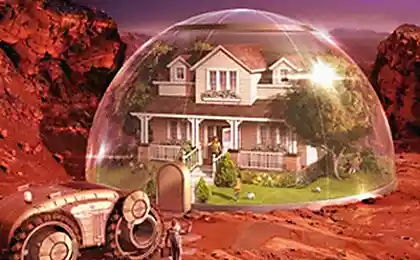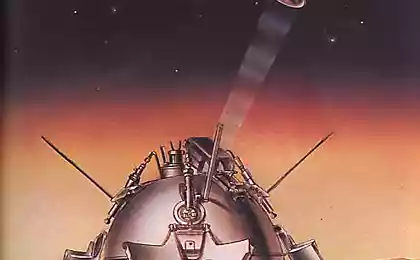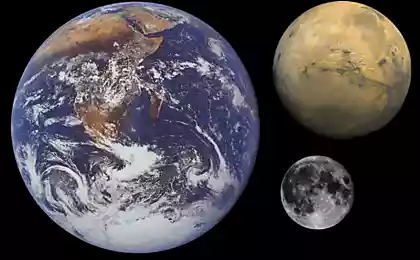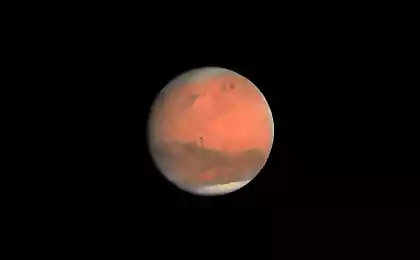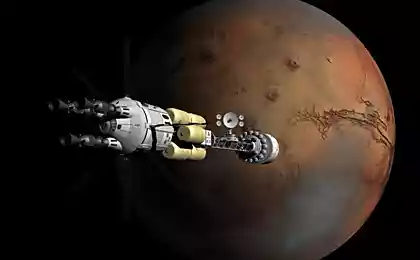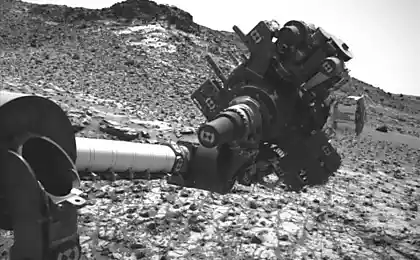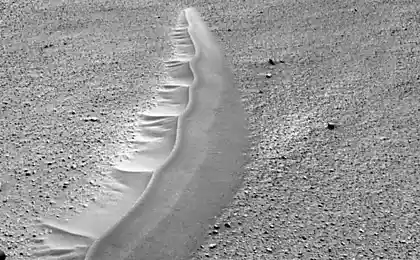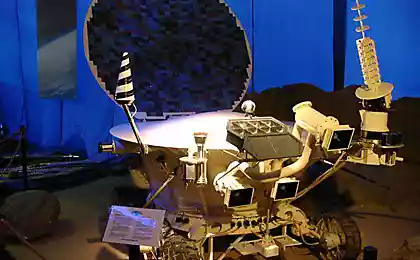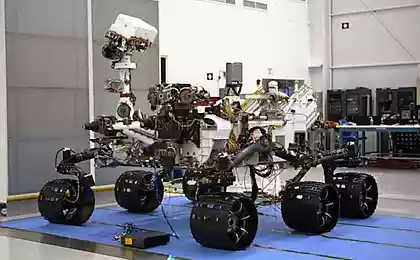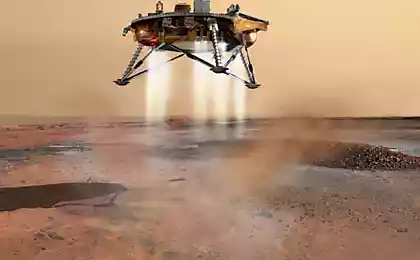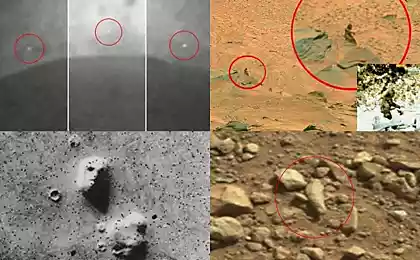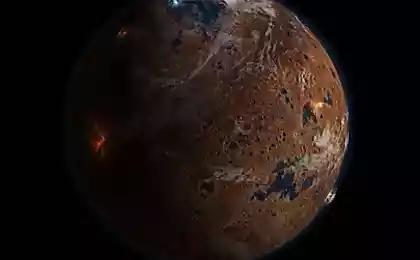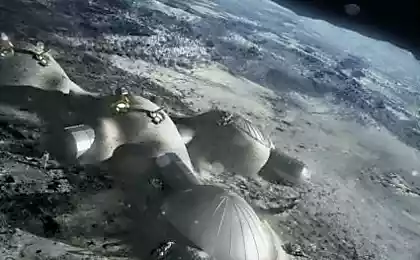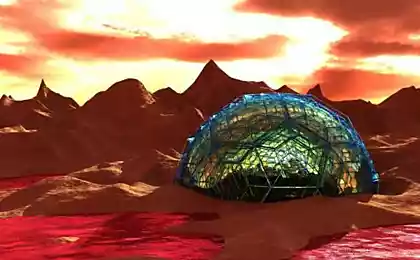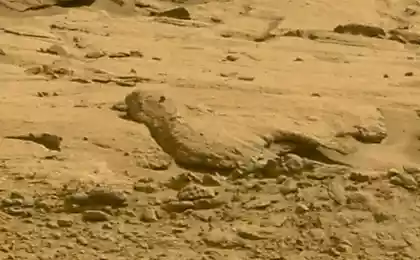618
Organics on Mars — what's next?

"We think life began on Earth 3.8 billion years ago, and our data suggests that on Mars at the same time had the same conditions — liquid water, thick atmosphere and organic matter, — said Caroline Freissinet from the control Centre of space flights of Goddard in NASA. — So if life emerged on Earth in these conditions, why can't it happen on Mars?".
Although the team of scientists, after recent discoveries "Curiosity", does not mean that the Gale crater specifically found life, the discovery suggests that the environment of Mars has a limited number of organic molecules that can be used as building blocks for life and an energy source for her. Previous analysis of this same mudstone (clay) conducted by "Curiosity" showed exactly what this place had once with water and chemical elements essential to life, as well as another source of chemical energy.
The team responsible for the instrument and sample analysis at Mars (SAM), which is equipped with the Rover "Curiosity", for the first time definitely confirmed the presence of organic molecules on Mars, the building blocks of life in all known forms, or rather, a wide range of molecules composed of carbon, hydrogen and oxygen atoms. Although, of course, organic molecules can be played in the course of the reactions without the participation of life, there is no concrete evidence that this finding was due to the presence of ancient Martian life or lack thereof. Examples of non-biological sources include chemical reactions in water of hot springs of ancient Mars or delivery of organic material on Mars in the form of fragments of interplanetary dust, asteroids and comets.
The surface of Mars is currently inhospitable as we know it, but there is strong evidence that the Red planet once had a climate that could support life for billions of years. For example, the details of the landscape, reminiscent of dry river beds, and the presence of minerals that form only in liquid water was recently discovered. The Rover "Curiosity" with his tool set, including SAM, went to Mars in 2011 precisely in order to learn more about the living environment of Mars in ancient times, studying the aspects of chemistry of the rocks and atmosphere.
Organic molecules found by the team of scientists were in a drilled sample of mudstone in Gale crater, where the Rover landed. Scientists believe that the crater on the spot, billions of years ago there was a lake, and mudstone formed from sediment in the lake. In addition, the claystone in about 20% of smectite clay. On Earth, this clay is known that provides a large surface area and optimal interlayer space for the concentration and preservation of organic components.

Organic molecules found by the team, also contain chlorine atoms and include chlorobenzene and several dichloramine like dichloroethane, dichlorobutane and dichloropropane. Chlorobenzene circulated more than others, its concentration is from 150 to 300 parts per billion. Chlorobenzene does not occur in nature on Earth. It is used in the production process in the creation of pesticides, herbicides, adhesives, paints and rubber. Dichloropropane is used as an industrial solvent and is classified as a carcinogen.
It is possible that this chlorine-free organic matter was in the claystone as such. But, according to scientists, it is likely that in the claystone were other sets of precursors of organic molecules, chlorine and organics formed from reactions in the SAM instrument, when the sample was heated for analysis. Perchlorates (a chlorine atom connected with four atoms of oxygen) are quite common on the surface of Mars. It is possible, by heating the sample, the chlorine from perchlorate combined with fragments of other organic molecules in the mudstone and formed chlorinated organic molecules, which recorded SAM.
In 1976, the Gas Chromatograph Mass Spectrometer, the instrument lander "Viking", has detected two simple chlorinated hydrocarbons, when heated the surface of Mars for analysis (harmatan and dichloromethane). But at that time could not exclude the possibility that the compounds were obtained using the tool. Although sources within the SAM instrument also produce chlorinated hydrocarbons, they do not produce more than 22 parts-per-billion of chlorobenzene, far lower than the amount of substance detected in the sample, and therefore, the team of scientists is confident that organic molecules really are present on Mars.
For the latest analysis system for collecting samples of "Curiosity" drilled hole in a mudstone and filtered fine particles through a sieve, then delivered a portion of the samples to the lab SAM. SAM analyzed the sample heated to 875 degrees Celsius and studied the pair with a quadrupole mass spectrometer, which identificeret molecules by their mass using electric fields. SAM also discovered components using gas chromatography mass spectrometer (GCMS). In this search mode, volatiles are separated according to how long they take to pass through the narrow pipe. Certain molecules interact with the sides of the tube and move slowly.
The first evidence for elevated levels of chlorobenzene and dichloramine released from the shales, "Curiosity" got on 290 Sol stay on Mars (30 may 2013). More than a year, scientists analyzed the results, spending on laboratory experiments using the SAM methods to make sure that the tool is not outputting the detected organic materials.

"The search for organics on Mars has been extremely difficult for us, said Daniel Glavin, co-author of the work. — First, we had to determine the conditions in the Gale crater, which would have found the desired concentration of organics in sediments. Then had to make sure that the fluid and dissolved substances are not oxidized and would not have destroyed the organics. Organics may also be destroyed by the impact of rocks on the surface of Mars to intense ionizing radiation. Finally, to determine what organic components are still alive, we had to determine exactly what chlormezanone components and possibly other strong oxidants in the sample does not destroy organic compounds and do not decompose them to carbon dioxide and chlorinated hydrocarbons when heated to SAM".
An important part of the mission, "Curiosity" was the preservation of the stones, which retain different combinations of substances, preserving organic matter.
"SAM and MSL teams worked together to achieve this result, said John Grotzinger from the California University. — By drilling further samples of the rocks in different places and map different geological histories, we managed to achieve such results. By the time we first saw organic molecules on Mars, it was unclear whether they were formed on Mars, however, additional drilling and analysis showed that, most likely, indeed Martian organics".
The last discovery "Curiosity"now, the Rover has detected organic compounds in soil and emissions of methane into the air. About what it can speak? "Curiosity" also found that 2% of Martian soil is represented by water. This is an important finding for future colonists of the red planet and for studying the question, could Mars be life.
Methane emissions, which scientists announced a few days ago, can be explained quite simply — you just need to wait and see again if they. From the end of November 2013 and January 2014 samples of the atmosphere collected and analyzed "Curiosity" showed a 10-fold increase in the concentrations of methane, a gas that on Earth is strongly connected with the life.
Two months later, when was taken new fence, gas left, creating a new mystery, since methane should remain in the Martian atmosphere not less than 300 years. The Rover will patiently sniff the air in search of methane, until the answer to this question, says Grotzinger.
If they discovered higher concentrations, the on-Board laboratory, the Rover will try to take the samples and to clean the methane from carbon dioxide for analysis. A detailed study of how methane disappears, can shed light on its origin and the causes of its periodical emissions. At present, scientists expect the release of methane from the crater Gale or places nearby.
If it is discovered a large release of methane, scientists will try to chemically analyze its isotopic composition, which again can shed light on its source. Perhaps it's the germs that existed in ancient times or now existing or by-product of geochemical processes.
The release shows that "Mars is currently active and its popularnosti communicates with the air," says Sushil the even worse than this one from the University of Michigan. Link this conclusion with the recent discovery that Mars has chlorbenzol organic — and it becomes clear that the chances that Mars is not as dead as we think, has grown substantially.
Source: hi-news.ru

